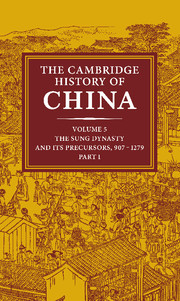Book contents
- Frontmatter
- Introduction: the Sung Dynasty and Its Precursors, 907–1279
- 1 The Five Dynasties
- 2 The Southern Kingdoms between the T’ang and the Sung, 907–979
- 3 Founding and Consolidation of the Sung Dynasty under T’ai-tsu (960–976), T’ai-tsung (976–997), and Chen-tsung (997–1022)
- 4 The Reigns of Jen-tsung (1022–1063) and Ying-tsung (1063–1067)
- 5 Shen-tsung’s Reign and the New Policies of Wang An-shih, 1067–1085
- 6 Che-tsung’s Reign (1085–1100) and the Age of Faction
- 7 The Reigns of Hui-tsung (1100–1126) and Ch’in-tsung (1126–1127) and the Fall of the Northern Sung
- 8 The Move to the South and the Reign of Kao-tsung (1127–1162)
- 9 The Reign of Hsiao-tsung (1162–1189)
- 10 The Reigns of Kuang-tsung (1189–1194) and Ning-tsung (1194–1224)
- 11 The Reign of Li-tsung (1224–1264)
- 12 The Reign of Tu-tsung (1264–1274) and His Successors to 1279
- Bibliography
- Glossary–Index
- References
2 - The Southern Kingdoms between the T’ang and the Sung, 907–979
Published online by Cambridge University Press: 28 March 2010
- Frontmatter
- Introduction: the Sung Dynasty and Its Precursors, 907–1279
- 1 The Five Dynasties
- 2 The Southern Kingdoms between the T’ang and the Sung, 907–979
- 3 Founding and Consolidation of the Sung Dynasty under T’ai-tsu (960–976), T’ai-tsung (976–997), and Chen-tsung (997–1022)
- 4 The Reigns of Jen-tsung (1022–1063) and Ying-tsung (1063–1067)
- 5 Shen-tsung’s Reign and the New Policies of Wang An-shih, 1067–1085
- 6 Che-tsung’s Reign (1085–1100) and the Age of Faction
- 7 The Reigns of Hui-tsung (1100–1126) and Ch’in-tsung (1126–1127) and the Fall of the Northern Sung
- 8 The Move to the South and the Reign of Kao-tsung (1127–1162)
- 9 The Reign of Hsiao-tsung (1162–1189)
- 10 The Reigns of Kuang-tsung (1189–1194) and Ning-tsung (1194–1224)
- 11 The Reign of Li-tsung (1224–1264)
- 12 The Reign of Tu-tsung (1264–1274) and His Successors to 1279
- Bibliography
- Glossary–Index
- References
Summary
introduction
The years between the collapse of T’ang dynastic authority that began in the mid-ninth century and the establishment of Sung authority in the later part of the tenth century were a period of great turmoil and change. The preceding chapter discussed the political history in north China through these decades. The present chapter focuses on the regions straddling and south of the Yangtze River. Historians have referred to the states that controlled this southern territory as the Ten Kingdoms, but this terminology is misleading. In fact, one of the so-called Ten Kingdoms is the Northern Han, located in northern Shansi. The Northern Han was a successor state to the Later Han dynasty of the north and belongs in a discussion of the northern dynasties. Of the nine kingdoms of the south that are covered in the following discussion, never more than seven existed at any one time (see figure 4 and table 3).
Four of these southern kingdoms governed their territories for almost the entire interregnum period: Wu-Yüeh (902–78), located in the Liang-che region of the Yangtze River delta, was the richest and most stable. Ch’u (907–64), centered in the region of modern Hunan, controlled the central Yangtze River valley. Ching-nan (907–63) was a tiny principality at the confluence of the Han and Yangtze rivers that survived among much larger kingdoms through diplomatic skill. Southern Han (909–71) occupied territory covered by the modern provinces of Kwangtung and Kwangsi. The Min kingdom (909–45) controlled the Fu-chien region (modern Fukien province) before it was assimilated by neighboring states after an internal fratricidal orgy of murder and mayhem.
- Type
- Chapter
- Information
- The Cambridge History of China , pp. 133 - 205Publisher: Cambridge University PressPrint publication year: 2009
References
- 6
- Cited by



